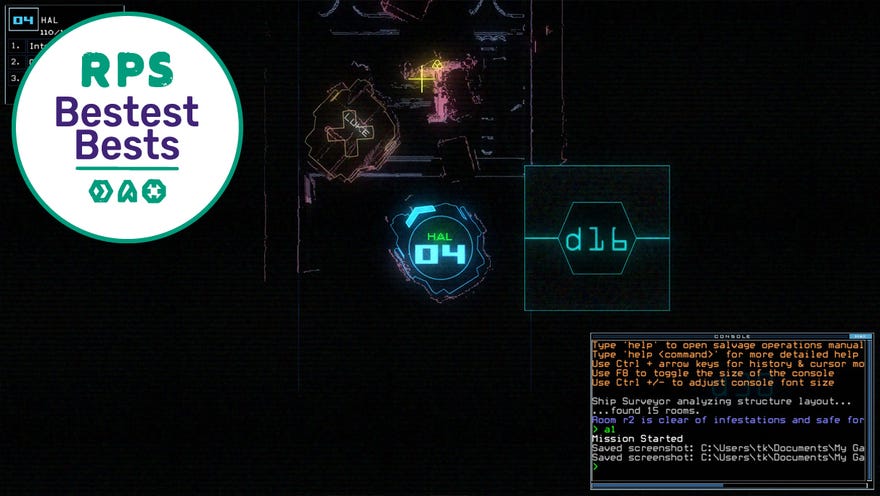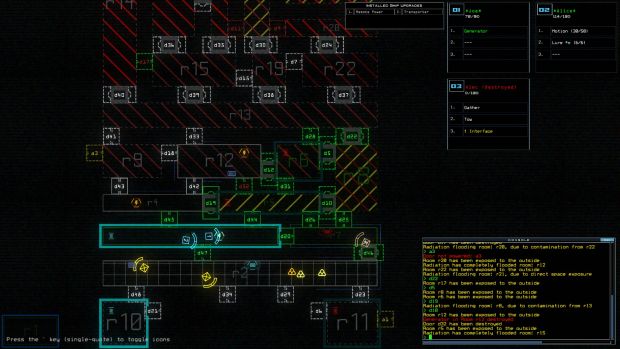Wot I Think: Duskers
A better Alien game than any official Alien game
After nine months in the womb of early access, Duskers has finally been born. Out it comes, snarling and writhing like the science fiction nightmare it is, covered in slime and engine oil. Congratulations, game developers! It's beautiful. No, really, it is. And here's Brendan to tell you why.
Have you seen Alien? Who am I kidding, of course you've seen Alien. If you haven't seen Alien, it's probably because you are an Alien, and you live millions of light-years away, and you're made of moss and haven't developed eyes yet, or cinema. No, you've seen Alien because it's essential. Well, I'm here to tell you that, as much as Alien is essential to any lover of sci-fi movies, Duskers is just as essential to any lover of sci-fi games. We've been looking for the Citizen Kane of videogames all these years, when really we should have been looking for the Ellen Ripley of videogames. Anyway, don't worry, we've found her.
Here's the skinny: you're You. You're on a ship all by yourself, floating through space. The only thing keeping you company is your computer screen and a small posse of remote-controlled drones. Something has happened, something bad, to everyone, everywhere. But it isn't clear exactly what. You're simply floating from derelict ship to derelict ship, trying to find out what's gone wrong. Why are there so many shipwrecks? What's with these corrupted logs? And why are there no survivors like you?
Your computer is an 1980s vision of the future - a command-driven box full of blinking green cursors and vector lines and old-school terminal typefaces. Even the pause menu gets in on the act. Will you LOOK at this pause menu.
Beautiful.
Anyway, you're confronted firstly with a map screen - I'll talk more about this overview later. It's what you'll be fiddling with in your downtime. Most of the time, however, you'll be getting your hands dirty scavenging. And by "getting your hands dirty" of course I mean "getting your drones eaten by unknown horrors". You see, when you board a derelict vessel, you're brought to a blueprint screen like this.
You can't see the whole ship, usually. You have to go in and look around, guiding your robot chums around the randomly-generated innards of these dead ships, looking for scrap, spare drones and (most elusively) information. You can take direct control of each drone by hitting '1' or '2' or whatever the bot's number is, then drive it about with the arrow keys. But often you'll be typing commands and simply watching as the little machines carry out their tasks.
This sounds daunting. Command-line interfaces are dead for a reason (i.e. they are bonkers), and here is a game that does not even entertain a mouse, not even in its main menu. WHAT WERE THE DEVELOPERS THINKING? But Duskers goes out of its way to make things simple. For example, all your drones start in a little docking pod. To get out, you type "a1" to unlock 'airlock 1' then, for instance, "navigate 1 2 3 r3" to move all three of your starting drones to 'room 3'. I have just described about a third of the commands you will type. Opening doors, closing doors and saying "move drone X to room X" is pretty much the game. That's very limiting, you might say. But you're a damned fool.
Drones do come with upgrades, allowing you to type other commands. "Gather" picks up scrap and fuel. "Tow" connects your bot to a disabled drone and carries it along behind. And "generator" plugs a drone into a power source and supplies juice to doors and airlocks. This is just the start. You can get upgrades to "interface" with shipboard computers, or "pry" jammed doors open, or detect "motion" in adjacent rooms. This last one is very important. You are going to detect a lot of motion.
This is the game's beating, leaping heart. You are not alone on any of these ships. Behind any of these doors might be some thing waiting to lunge at your drones and tear them asunder. And the loss of a single drone (and therefore any upgrades it has installed) is devastating. You have to work hard to keep your drones in good shape. You invest in them, you repair them with scrap, you trust them with expensive upgrades. You even rename them, say, after your colleagues.
Because of this, losing a drone is often a head-in-your-hands moment. It can be as demoralising as losing any XCOM major, as distressing as your Minecraft cabin catching on fire. You can turn off the permadeath in the difficulty options but both the developers and myself would recommend you to stay far away from that button. Watching a drone succumb to the mysterious terrors of these shipwrecks is not the essence of this game but recovering from that loss is. Or, in many cases, the attempt to recover.
Here's an example. I put together a plan to "herd" a monster (I don't know what kind) through a series of rooms and flush it out an airlock. Naturally, it all went horribly wrong. The drone I was using to power the doors (poor Alec) was attacked. And now a radiation leak was filling the ship room by room. During this ruckus, the aforementioned monster had somehow gotten into my docking vessel where it promptly trashed another two drones after I accidentally locked it inside with them in a panic. The whole thing was a disaster.
Three of my robots were now dead or disabled - Alec, Jim and Graham. But a single drone had survived. It was Alice. She had been sheltered in the one nook of the derelict that was safe from radiation. But how was I supposed to get her back on board the docking pod and safely home - the alien was inside. I couldn't dock the shuttle somewhere else and open it, to cast the alien back onto the ship, because that would fill my shuttle with radiation. The only safe docking point was the A4 airlock - exactly where Alice was. I had to come up with a plan.
Luckily, Alice found a disabled drone in her room and stripped its corpse, finding a "lure" upgrade. Together with a mine we created an impromptu trap that would entice the alien away from Alice. I tucked her into a corner of the room, opened the airlock and prayed.
It worked. Not only did the monster go for the trap, giving Alice her chance to sneak back onto the shuttle, but she also towed that busted drone back with her. I slammed the airlock closed with "a4" and typed "exit". I lost Alec that day - my hardworking generator bot. But, thanks to Alice, I saved the others. We even gained a 'Pip'.
A playthrough of Duskers is full of small tales like this. One time, John, my point-bot, was killed by some kind of... swarm - all because I forgot to turn his shiny new turret on. Another time, I accidentally flushed my gathering drone Quintin out of an airlock, because I had hastily typed "a1" instead of "dock a1". In that instance, I laughed my ass off. But afterwards I was obviously devastated.
My point is: while all this is happening, it feels fantastic. Fantastic and frenetic. On a ship marked "stable" you can afford to take your time but a "volatile" ship will have radiation leaks, or incoming asteroids, or malfunctioning doors, or punctured hulls. All of which threaten to upend your plans and force you to rethink, react or retreat, quickly, back to the nearest room with a stable airlock.
And the way it all looks. It's one thing to make a game look like this, hooking into everyone's current lust for "retro-futurism" or whatever it is we're calling nostalgia now, but it's another thing for the feel, atmosphere and mechanics of your game to perfectly match that style. This is something Duskers does unnaturally well. It is a claustrophobic, tense recreation of all the sci-fi horror you love. It's a game of desperately trying to come up with solutions with almost no resources. Imagine someone has handed you a toolbox and told you to build a fridge, then you open said toolbox only to find some sellotape, a pair of nail clippers and a single permanent marker. How the fuck are you going to make a fridge out of that? You have no idea, but damned if you won't come up with something. It's a tense, worrisome survival horror about making do.
Even the overview screen, outside of the scavenging sojourns, is all about making the best of what you've got. Your ship can move between derelicts - government ships, space stations, fuel depots, military vessels, auto-trading hubs, and so on. And this meandering uses one type of fuel (propulsion). Another type of fuel (jump fuel) lets you hop to a new system entirely, where you'll find a fresh collection of derelicts. On and on you go, roguelike style, until you hit a stargate taking you to the galaxy next door. It's the most noticeable glimpse of FTL's genetic footprint - the need for fuel, the struggle to keep going.
Yet there's much more to consider. Other screens show your drones' loadouts, your ship's configuration and a kind of scrap workshop. All the resources gathered during your frightful boarding parties goes here and trust me when I say you will never have enough to do everything you want to do. For example, your ship's "remote power" ability is likely to break beyond repair during the next mission due to overuse. But so is the upgrade on one of your drones that lets you detect motion. And you only have enough scrap to fix one of them. What do you do? This exact dilemma harassed me on more than one occasion. The scavenging sections may force you to make quick and panicked decisions, but the 'downtime' confronts you with choices that are just as difficult, just as important. This is what real survival horror plays like. The entire game reeks of consequence.
Again, there are difficulty options for you to toggle (and impressively detailed options at that) but to enjoy the pressure and desperation to its fullest I recommend playing it without alterations. It is an unforgiving game at first, as you come to learn the commands (and the inevitable joy of the "alias" file) but the learning curve is smooth and every death to the cold of space is a little red thread in a horrible, sublime tapestry, full of desperate scenes. Once, I had to use the staticky feed of a disabled drone to check to see if an alien was still in a room. Another time, I commandeered a huge barge, with enough room to store 100 pieces of scrap, despite only having 6 pieces to house. This is what you have waiting for you: a ridiculous and pointless horror story, and a slow death. It's wonderful.
I began this review with a comparison to Alien, the nostalgia for which has been thoroughly mined in recent years within the games industry, in good ways and bad. This is saying a lot - because I enjoyed Alien: Isolation immensely - but I don't think any Alien games have come as close as this has to recreating the same feeling as the original movie - panic, claustrophobia, distrust of machines, and a gut fear of the unknown.
Duskers is out now for Windows, Mac and Linux via Steam, GOG and Humble.





















